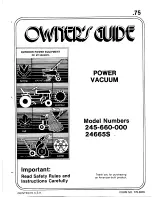
SECTION 3: OPERATION
3.10 Starting Procedures
3.11 Starting a Welch Aspiration/Filtration Vacuum System
Before attaching the pump to a system, familiarize yourself with the function and action of the Aspiration/
Filtration Vacuum System that you have acquired. Review the power requirements as described in
Section 2.60. Welch recommends running the pump for a few minutes to warm it up, before use. The
warm-up improves the pumps ability to handle humid air. Set the device on a level, sturdy surface so the
controls can be easily reached and adjusted. Be certain that the tubing extends from the pump vacuum
inlet through the in line fi lter to the collection vessel. Connect one end of the application tubing to the lid
vacuum port marked “application”
Note: The in-line hydrophobic fi lter is designed to prevent foreign material from being drawn into the
pump. Pump performance may decrease if the hydrophobic fi lter gets wet or build up of foreign materials.
Change the hydrophobic fi lter periodically to maximize pump performance and protection.
1. Be sure that the power switch is in the OFF (down) position. Plug in the device and turn the switch to
the ON (up) position.
2. Adjust the rate of aspiration using the control knob and vacuum gauge.
3. Aspiration can be actuated by 1) turning pump on/off using a foot switch or 2) controlling liquid fl ow
using a handheld pipettor.
See 9.21 or visit www.welchvacuum.com for fl uid control options and pipette/manifold confi gurations
3.12 Cleaning The Device
1. Make sure the ON/OFF switch is in the OFF (down) position.
2. Unplug the device from the wall outlet and allow suction level to drop.
3. Remove the application tube from the lid vacuum port. Tubing can be cleaned after every use.
4. Remove the pump tubing from the top of the jar lid.
5. Remove the jar from the holder and place on a fi rm, fl at surface. Release the tabs and lift the lid
from the jar. Dispose of aspirated fl uid appropriately.
6. Wash the jar, gasket, lid and tube in a hot water/dish washing detergent solution and rinse with hot tap
water. The collection vessel and lid are autoclaveable and bleach resistant.
7. Wipe the outside of the case with a clean, damp cloth after each use.
3.20 Leak Detection
3.21 If a leak exists, the pump must remove added volume of gas to maintain the desired vacuum. Check
all tubing connections and ensure that collection vessel gasket is clean, in good repair, and fi ts fl ush
to container and lid contact surfaces. Secure lid tabs fi rmly to compress gasket and facilitate proper
sealing. Leaks for these pumps can be located by slightly pressuring the system and painting the
suspected area with a thick soap solution. Escaping air will produce soap bubbles.
8



































